METRO ADJUSTS ITS REIMAGINED BUS ROUTES 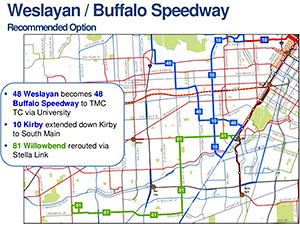 So the reviews of the proposed “System Reimagining” of Metro bus routes are in and . . . generally positive, but a big bunch of letter-writers hated what the new layout might or might not do to public transit along Weslayan, Jones Rd. and Jersey Village, and the Louetta and Vintage Lakes area. So the newly revised map, which Metro unveiled at its board meeting yesterday, recommends some adjustments to proposed service changes in those areas. The new 48 line, for example, which formerly was planned to run straight down Weslayan to the South Loop, would now connect the Northwest Transit Center to Greenway Plaza, the Rice Village, and the Med Center; the new 10 route down Kirby Dr. would now extend further south to S. Main St. Don’t like these changes to the changes? A few alternative route adjustments were presented as well. If the new plans are approved at next month’s meeting, the new bus routes and schedules should go into effect next June. Here’s the whole revised reimagined network map in one big PDF. [Metro; previously on Swamplot; all plan materials]
So the reviews of the proposed “System Reimagining” of Metro bus routes are in and . . . generally positive, but a big bunch of letter-writers hated what the new layout might or might not do to public transit along Weslayan, Jones Rd. and Jersey Village, and the Louetta and Vintage Lakes area. So the newly revised map, which Metro unveiled at its board meeting yesterday, recommends some adjustments to proposed service changes in those areas. The new 48 line, for example, which formerly was planned to run straight down Weslayan to the South Loop, would now connect the Northwest Transit Center to Greenway Plaza, the Rice Village, and the Med Center; the new 10 route down Kirby Dr. would now extend further south to S. Main St. Don’t like these changes to the changes? A few alternative route adjustments were presented as well. If the new plans are approved at next month’s meeting, the new bus routes and schedules should go into effect next June. Here’s the whole revised reimagined network map in one big PDF. [Metro; previously on Swamplot; all plan materials]
Tag: Public Transportation
COMMENT OF THE DAY: NAVIGATING HOUSTON’S HEAVILY CONGESTED FUTURE  “I’m for better transit (I won’t be mode-specific here), but it should never be sold as making the streets less congested for you to drive around on. While it may take some cars off the streets, Houston’s congestion is likely to be massive enough that you’d never notice. Do NYC and LA have uncongested streets? Obviously not, even though both cities have much much better transit than Houston — meaning they have better alternatives to being in congestion and having to find parking. Congestion and difficult parking are our future (I wager even with self-driving cars, if they’re all personally owned) — everyone needs to be at peace with that.” [Local Planner, commenting on Killing Any Chance of Later Rail Conversion on the New Post Oak Bus Lanes; The Bedbugs of Beverly Hill] Illustration: Lulu
“I’m for better transit (I won’t be mode-specific here), but it should never be sold as making the streets less congested for you to drive around on. While it may take some cars off the streets, Houston’s congestion is likely to be massive enough that you’d never notice. Do NYC and LA have uncongested streets? Obviously not, even though both cities have much much better transit than Houston — meaning they have better alternatives to being in congestion and having to find parking. Congestion and difficult parking are our future (I wager even with self-driving cars, if they’re all personally owned) — everyone needs to be at peace with that.” [Local Planner, commenting on Killing Any Chance of Later Rail Conversion on the New Post Oak Bus Lanes; The Bedbugs of Beverly Hill] Illustration: Lulu
WHEN HOUSTON HAD A PLAN, AND FUNDING, FOR A DOWNTOWN PEOPLE MOVER 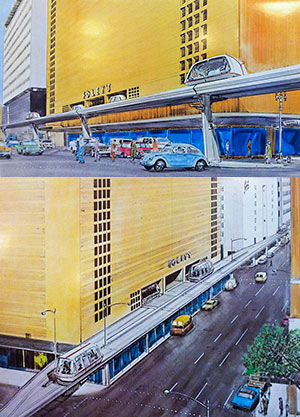 Digging into 40-some-year-old documents resting comfortably in the Houston Metropolitan Research Center at the Julia Ideson Library, Christopher Andrews pieces together the story behind the Downtown People Mover once planned for Houston. Houston was approved to receive $33 million in federal funding for the project in the mid-seventies, along with 4 other cities, but withdrew its application shortly after Harris County voters approved the creation of Metropolitan Transit Authority in 1978. After Houston dropped out (along with Cleveland and St. Paul), actual downtown people movers ended up getting built in Detroit and Miami. “The City of Houston’s 1976 proposal to the UMTA,” writes Andrews, “called for a 1.09 mile system, composed of 2.25 lane miles of track bisecting the ‘heart of the downtown core,’ stretching from the Cullen Center to the Harris County complex. It was intended to be fully owned, operated, planned and financed by the City of Houston, and was said to garner ‘strong and wide local support.'” A later report commissioned by the city showed alternatives to that north-south route along Milam St., including an elevated line running down Main St. past (and into) the (recently demolished) Foley’s building. [Not of It] Renderings: Sperry Systems Management/Houston Metropolitan Research Center
Digging into 40-some-year-old documents resting comfortably in the Houston Metropolitan Research Center at the Julia Ideson Library, Christopher Andrews pieces together the story behind the Downtown People Mover once planned for Houston. Houston was approved to receive $33 million in federal funding for the project in the mid-seventies, along with 4 other cities, but withdrew its application shortly after Harris County voters approved the creation of Metropolitan Transit Authority in 1978. After Houston dropped out (along with Cleveland and St. Paul), actual downtown people movers ended up getting built in Detroit and Miami. “The City of Houston’s 1976 proposal to the UMTA,” writes Andrews, “called for a 1.09 mile system, composed of 2.25 lane miles of track bisecting the ‘heart of the downtown core,’ stretching from the Cullen Center to the Harris County complex. It was intended to be fully owned, operated, planned and financed by the City of Houston, and was said to garner ‘strong and wide local support.'” A later report commissioned by the city showed alternatives to that north-south route along Milam St., including an elevated line running down Main St. past (and into) the (recently demolished) Foley’s building. [Not of It] Renderings: Sperry Systems Management/Houston Metropolitan Research Center
COMMENT OF THE DAY: RAILROADED  “Southern Pacific (not Union Pacific, as one writer claimed), demolished this station in 1959. Critics may blame Houstonians for failing to rally and save the building, but the fact is that the modern architectural preservation movement didn’t start until the early 1970s, and even my architecturally hip home town of Chicago let some classic beauties like Louis Sullivan’s Stock Exchange slip away before public sentiment for preservation began to build. The first downtown railroad-station preservation-restoration project did not take place until 1973, when the Southern Railway’s vacant Terminal Station in Chattanooga was transformed into a restaurant and hotel complex.
If anybody has any photos of the interior of the SP station in Houston I would like to examine them for a book I’m writing about what happened to each of the big downtown stations in North America. SP’s Houston Station was designed by Texas’s most celebrated architect, Wyatt C. Hedrick, who also designed the Shamrock Hotel, the T&P station in Fort Worth, and dozens of admired hotels, factories and commercial buildings. Photos of his T&P station are all over the Internet but SP demolished his Houston station before anyone had a chance to make any good photos.” [F.K. Plous, commenting on The Secret Train Station Hidden Downtown] Illustration: Lulu
“Southern Pacific (not Union Pacific, as one writer claimed), demolished this station in 1959. Critics may blame Houstonians for failing to rally and save the building, but the fact is that the modern architectural preservation movement didn’t start until the early 1970s, and even my architecturally hip home town of Chicago let some classic beauties like Louis Sullivan’s Stock Exchange slip away before public sentiment for preservation began to build. The first downtown railroad-station preservation-restoration project did not take place until 1973, when the Southern Railway’s vacant Terminal Station in Chattanooga was transformed into a restaurant and hotel complex.
If anybody has any photos of the interior of the SP station in Houston I would like to examine them for a book I’m writing about what happened to each of the big downtown stations in North America. SP’s Houston Station was designed by Texas’s most celebrated architect, Wyatt C. Hedrick, who also designed the Shamrock Hotel, the T&P station in Fort Worth, and dozens of admired hotels, factories and commercial buildings. Photos of his T&P station are all over the Internet but SP demolished his Houston station before anyone had a chance to make any good photos.” [F.K. Plous, commenting on The Secret Train Station Hidden Downtown] Illustration: Lulu
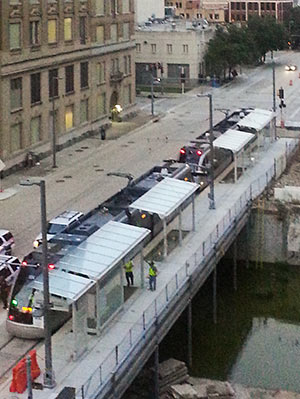 No, no one’s expecting Metro’s 2 new light-rail lines to open any sooner than late December (as Swamplot reported last week), but some progress toward that goal is now visible on portions of the East End and Southeast lines: “Live wire” or powered testing of the downtown tracks began this week. The photo at right, sent in by a reader, shows a Metro train moving unescorted along the tracks on Capitol St. for the first time.
No, no one’s expecting Metro’s 2 new light-rail lines to open any sooner than late December (as Swamplot reported last week), but some progress toward that goal is now visible on portions of the East End and Southeast lines: “Live wire” or powered testing of the downtown tracks began this week. The photo at right, sent in by a reader, shows a Metro train moving unescorted along the tracks on Capitol St. for the first time.
- Southeast and East End Line coverage [Swamplot]
Photo: Nathan Juett
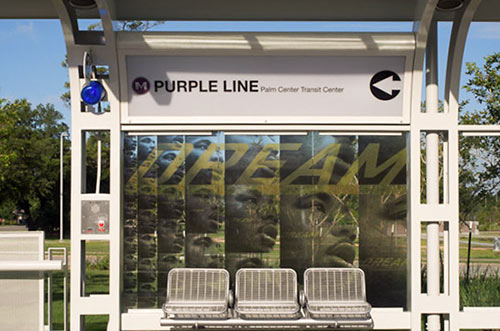
There’s still “some uncertainty” over the exact schedule, but all the pieces needed to allow Metro to open Houston’s second and third light-rail lines won’t be in place until late December, according to reports delivered to a committee of the transportation organization’s board of directors last Friday. Previously, an opening date sometime this fall had been projected for the Southeast and East End lines (though the far eastern end of the East End line won’t come on line until a newly planned overpass is built under over the Union Pacific East Belt freight rail line between the future Altic and Cesar Chavez stations). Delays in the delivery of trains aren’t the sole reason for the late openings, however.
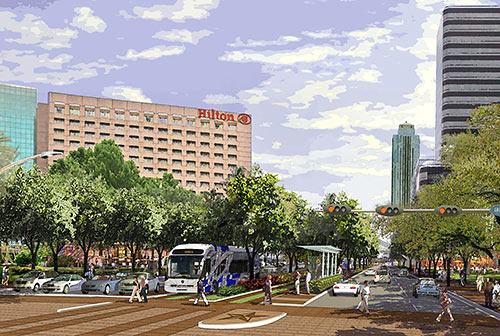
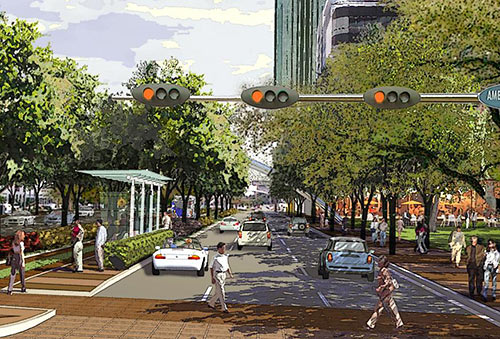
Here are some of the purty watercolor renderings the Uptown District has been presenting of what Post Oak Blvd. will look like after the addition of 2 dedicated bus lanes down its middle. The proposed changes to the thoroughfare won’t take away any of the 6 existing car lanes or 13 existing left-turn-signal lanes. There’ll be a few modifications, though: new protected-left-turn signals will be put in at West Briar Lane and Fairdale, for example, and 3 median openings will be closed. The space for the buses and 8 transit stations along the Boulevard between the West Loop and Richmond Ave will come from acquiring 8 feet of right-of-way from each side of the existing street. The bus lanes and light-rail-style stations will go in the median:
COMMENT OF THE DAY: WHAT IT WOULD TAKE TO BUILD A SUBWAY IN HOUSTON 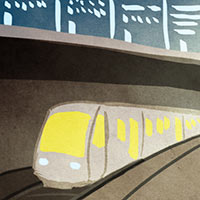 “A subway WILL work in Houston, albeit at a significantly higher cost. I’m a civil engineer who builds tunnels, nationwide. They’re not even significantly more expensive in Houston than elsewhere. Tunnels in LA, NY, Chicago, Montreal, London etc all have to deal with bedrock — which is very expensive to tunnel through. Instead, Houston uses open-cut excavation and massive soil amendments + ground water pumping to tunnel. For example — the depressed portions of US-59 from Shepherd to Montrose (or the depressed portion of Beltway 8 from Boheme to I-10) are essentially a tunnel with no roof because they’re lower than the bayou and the ground water table; it took expensive soil amendments and pumps to build that, the same as a subway. Our commuter rail tunnel projects in LA are bidding for between $18M-$20M per mile of track, while the at-grade portions are only about $4M per mile. We consistently find that tunnels cost about 4x-5x as much as at-grade track. Meanwhile, elevated track costs roughly $25M a mile (6x at-grade costs). . . .” [Ornlu, commenting on Comment of the Day: How About a Rail Line Along the Bayou?] Illustration: Lulu
“A subway WILL work in Houston, albeit at a significantly higher cost. I’m a civil engineer who builds tunnels, nationwide. They’re not even significantly more expensive in Houston than elsewhere. Tunnels in LA, NY, Chicago, Montreal, London etc all have to deal with bedrock — which is very expensive to tunnel through. Instead, Houston uses open-cut excavation and massive soil amendments + ground water pumping to tunnel. For example — the depressed portions of US-59 from Shepherd to Montrose (or the depressed portion of Beltway 8 from Boheme to I-10) are essentially a tunnel with no roof because they’re lower than the bayou and the ground water table; it took expensive soil amendments and pumps to build that, the same as a subway. Our commuter rail tunnel projects in LA are bidding for between $18M-$20M per mile of track, while the at-grade portions are only about $4M per mile. We consistently find that tunnels cost about 4x-5x as much as at-grade track. Meanwhile, elevated track costs roughly $25M a mile (6x at-grade costs). . . .” [Ornlu, commenting on Comment of the Day: How About a Rail Line Along the Bayou?] Illustration: Lulu
COMMENT OF THE DAY: HOW ABOUT A RAIL LINE ALONG THE BAYOU?  “I always thought a line down Memorial Drive along Buffalo Bayou would be awesome. It seems like it would be pretty easy to adapt the stretch of Memorial from downtown to Shepherd in to a rail friendly street — there are pedestrian crosswalks already, abundant lanes, and no stop-light intersections to contend with. They could take a lane or 2 from Memorial Drive, make a new right of way down the park, or even make an elevated line (which all of them should have been). The stops could tie in with cross streets or some the existing pedestrian bridges. This could be a real ‘showcase’ line for the city being right next to what seems to becoming Houston’s prime inner city park location. The line could continue all the way into Memorial Park and maybe even somehow get to the Galleria.
And of course Swamplot is the best forum for me to lobby my vision.” [actualarch, commenting on What’s the Point of Metro’s New Buffalo Bayou Bridge Under I-45?] Illustration: Lulu
“I always thought a line down Memorial Drive along Buffalo Bayou would be awesome. It seems like it would be pretty easy to adapt the stretch of Memorial from downtown to Shepherd in to a rail friendly street — there are pedestrian crosswalks already, abundant lanes, and no stop-light intersections to contend with. They could take a lane or 2 from Memorial Drive, make a new right of way down the park, or even make an elevated line (which all of them should have been). The stops could tie in with cross streets or some the existing pedestrian bridges. This could be a real ‘showcase’ line for the city being right next to what seems to becoming Houston’s prime inner city park location. The line could continue all the way into Memorial Park and maybe even somehow get to the Galleria.
And of course Swamplot is the best forum for me to lobby my vision.” [actualarch, commenting on What’s the Point of Metro’s New Buffalo Bayou Bridge Under I-45?] Illustration: Lulu
SNøHETTA’S CENTRAL STATION CANOPY DESIGN IS OFFICIALLY DEAD 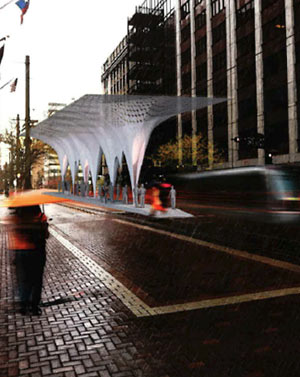 Whatever glimmer of hope supporters of a distinctive Central Station were holding out for Metro somehow following through on its design competition or for Snøhetta’s winning canopy design have officially been dashed, Dug Begley reports: “Metropolitan Transit Authority chairman Gilbert Garcia and interim CEO Tom Lambert confirmed [last] week that timing crippled any chance of resurrecting a winning design. Instead officials will build their basic canopy for the block-long stop between Capitol and Rusk streets on Main Street.” [The Highwayman; previously on Swamplot] Rendering: Snøhetta
Whatever glimmer of hope supporters of a distinctive Central Station were holding out for Metro somehow following through on its design competition or for Snøhetta’s winning canopy design have officially been dashed, Dug Begley reports: “Metropolitan Transit Authority chairman Gilbert Garcia and interim CEO Tom Lambert confirmed [last] week that timing crippled any chance of resurrecting a winning design. Instead officials will build their basic canopy for the block-long stop between Capitol and Rusk streets on Main Street.” [The Highwayman; previously on Swamplot] Rendering: Snøhetta
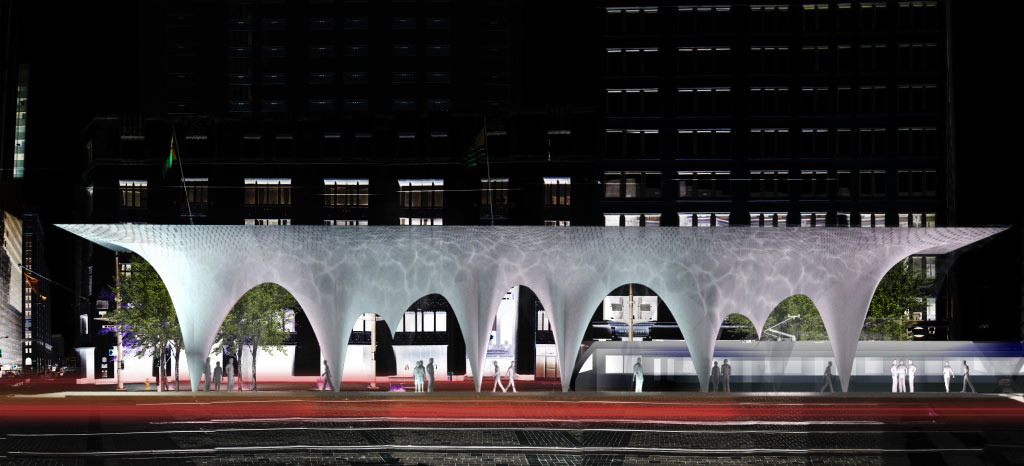
Craig Dykers of Norway-and-NYC architecture firm Snøhetta tells Chronicle reporter Dug Begley his firm has been working for more than a year on its own and with local contractors to lower the construction costs on his firm’s competition-winning design for Metro’s Central Station canopy — in between its work, that is, on a little reconstruction project for New York called Times Square. Snohetta’s design for a canopy made of thin layers of concrete was meant to highlight rainfall, making falling water “a feature of the design.”
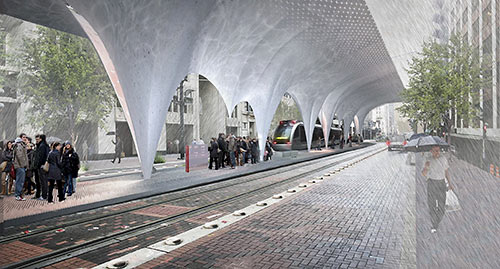
Wondering whatever happened to the competition entries from architects competing for the new Main St. light rail station planned for the block between Capitol and Rusk streets downtown, where the new East End and Southeast Lines cross the existing rail line? After a long silence about the project, Metro board members voted yesterday to scrap the plan for a signature station at that location, and to spend $1.05 million to build a standard canopy there instead.
The winner of the invitation-only competition — which included SHoP Architects, LTL Architects, and Neil Denari from New York as well as Houston’s Interloop—Architecture — was New York and Oslo firm Snøhetta. But who’d have known it?
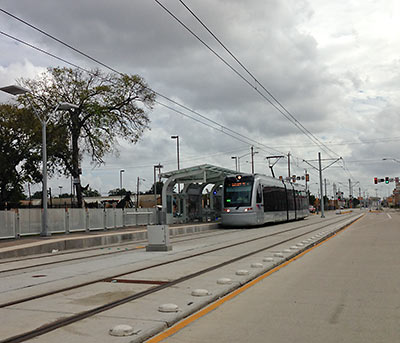
There’s been a Metro train siting at the new Quitman station of the North Line extension, just south of the train’s turnoff from North Main, reader Joel Balderas reports. Unlike earlier appearances, the train appears to be operating under its own power. Here’s the photo evidence:
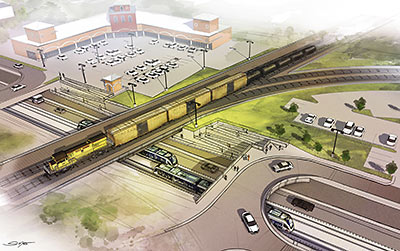
That no-tracks land along Harrisburg Blvd. between 66th and Cowling on the East End Line is supposed to look something like the underpass that these new renderings depict. Right now, though, Harrisburg isn’t passing under anything — but lying in wait instead between the nearly completed eastern and western sections of the line that stop here dead in their tracks. Though Mayor Parker announced more than 2 years ago that the East End Line would get $20.6 million in diverted funds to build the Hughes Underpass below the Union Pacific East Belt freight rail line, construction hasn’t started. Why? Well, it appears that Metro hasn’t selected a company yet.
GOT ANY BIG IDEAS FOR METRO’S FUTURE? 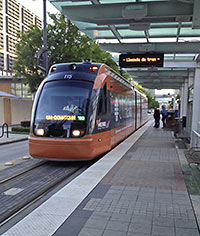 You know you’ve thought about Metro. And it just so happens that Metro has been thinking about you: Officials plan to spend the next year and a half imagineering a revamped transit system, almost as though from scratch, and they’ve set up a 15- to 20-minute survey to solicit feedback from folks who actually ride the things. Metro’s Christof Spieler explains to KUHF: “You can’t bring in an expert and get the right answer because there’s no one right answer to [the] question. So the first stage of this, which is what we’re getting public input on right now, is actually what should our goals be. What kind of system are we trying to operate? What is the purpose of that system?” If you wanna chip in and take the survey, click here. [KUHF; Transit System Reimagining; previously on Swamplot] Photo: Allyn West
You know you’ve thought about Metro. And it just so happens that Metro has been thinking about you: Officials plan to spend the next year and a half imagineering a revamped transit system, almost as though from scratch, and they’ve set up a 15- to 20-minute survey to solicit feedback from folks who actually ride the things. Metro’s Christof Spieler explains to KUHF: “You can’t bring in an expert and get the right answer because there’s no one right answer to [the] question. So the first stage of this, which is what we’re getting public input on right now, is actually what should our goals be. What kind of system are we trying to operate? What is the purpose of that system?” If you wanna chip in and take the survey, click here. [KUHF; Transit System Reimagining; previously on Swamplot] Photo: Allyn West

